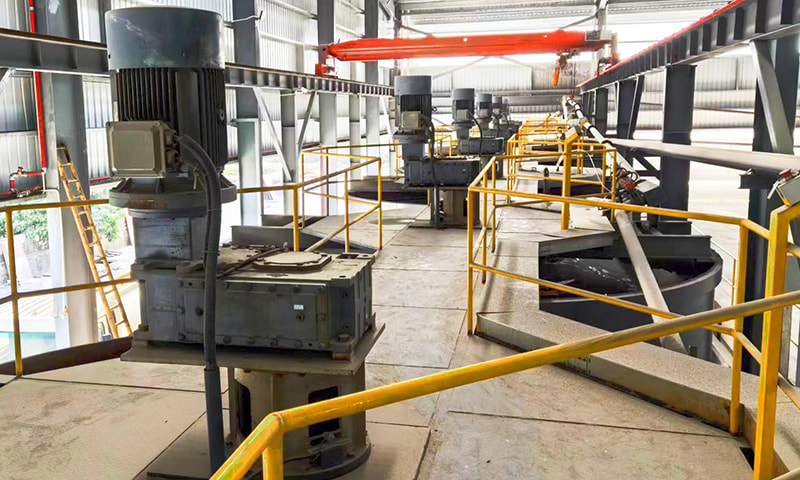The construction industry is undergoing a transformation driven by advanced building materials and innovative manufacturing techniques. Among these, the AAC block production line has emerged as a cornerstone of modern construction, offering efficiency, durability, and sustainability. Central to the production line is the AAC product autoclaving section, a critical stage that ensures the structural integrity and quality of aerated concrete blocks.
Understanding the AAC Block Production Line
The AAC block production line integrates multiple processes, from raw material preparation to final block curing. The production line is designed to maximize automation, minimize material wastage, and deliver consistent block quality. Key stages of the production line include mixing, molding, pre-curing, cutting, and autoclaving. Among these, the autoclaving section plays a decisive role in determining the physical properties and performance of AAC blocks.
| Stage | Function | Key Considerations |
|---|---|---|
| Raw Material Preparation | Accurate weighing and mixing of cement, lime, sand, and additives | Consistency, moisture control |
| Molding | Formation of blocks with precise dimensions | Density, shape uniformity |
| Pre-curing | Initial solidification to allow safe handling | Temperature, humidity |
| Cutting | Precise sizing and surface preparation | Dimensional accuracy |
| Autoclaving | High-pressure steam curing to strengthen blocks | Temperature, pressure, curing duration |
The Importance of the Autoclaving Section
The AAC product autoclaving section is the heart of the production line. During this stage, freshly cut AAC blocks undergo high-pressure steam curing inside autoclaves. This process accelerates the chemical reaction of lime and cement with water, a phenomenon known as hydrothermal curing, which imparts strength and durability to the blocks. Unlike conventional curing methods, autoclaving ensures uniform properties throughout the block, making it resistant to cracking, shrinkage, and other structural defects.
Key Benefits of Autoclaving
Enhanced Compressive Strength: Properly autoclaved AAC blocks exhibit load-bearing capacity, essential for high-rise construction and structural applications.
Dimensional Stability: The controlled environment in the autoclave minimizes deformation, ensuring precise block dimensions.
Durability and Longevity: Autoclaved blocks are resistant to environmental stressors, including moisture and temperature fluctuations.
Energy Efficiency: Modern AAC autoclaving sections optimize steam consumption and reduce energy waste during curing.
| Benefit | Description |
|---|---|
| Compressive Strength | Blocks achieve uniform and high load-bearing capacity |
| Dimensional Accuracy | Minimizes shrinkage and maintains precise dimensions |
| Durability | Resistant to moisture, frost, and structural stress |
| Energy Efficiency | Optimized steam consumption and reduced energy loss |
Technological Advancements in Autoclaving
Recent developments in AAC autoclave technology have focused on automation, process monitoring, and energy efficiency. Continuous autoclave systems, for example, allow blocks to move through the autoclave without manual intervention, reducing labor requirements and maintaining consistent curing conditions. Automated temperature and pressure controls ensure that each batch receives uniform treatment, enhancing product quality across the production line.
Moreover, energy-efficient autoclaving methods integrate heat recovery systems, which reuse steam and reduce operational costs. Advanced monitoring systems track humidity, temperature, and pressure in real-time, allowing for immediate adjustments to maintain curing conditions. These technologies collectively improve productivity while minimizing environmental impact.
| Technology | Function |
|---|---|
| Continuous Autoclave System | Reduces manual handling, ensures consistent curing |
| Automated Controls | Real-time monitoring of temperature, pressure, and humidity |
| Heat Recovery Systems | Reuses steam to save energy |
| Quality Monitoring Software | Ensures uniform block strength and dimensional stability |
Integration with the Entire AAC Block Production Line
The AAC product autoclaving section does not operate in isolation; it is seamlessly integrated into the broader AAC block production line. Efficient coordination between molding, pre-curing, cutting, and autoclaving is essential for maintaining production efficiency and block quality. Any disruption in one stage can affect downstream processes, emphasizing the importance of a well-designed production line.
The precise cutting before autoclaving ensures uniform steam penetration and consistent block strength. Similarly, proper pre-curing reduces the risk of damage during handling, allowing the autoclaving section to operate at peak efficiency. By optimizing each stage in relation to autoclaving, manufacturers achieve higher throughput and product performance.
Environmental and Economic Considerations
Autoclaving is not only a technical process but also a driver of sustainability in construction. Energy-efficient autoclaving reduces carbon emissions compared to traditional curing methods. Furthermore, the production of AAC blocks generates minimal construction waste due to precise molding and cutting, contributing to sustainable building practices.
From an economic standpoint, the integration of advanced autoclaving technology increases operational efficiency. Reduced energy consumption, lower labor costs due to automation, and consistent block quality translate into cost savings for producers. Additionally, high-quality AAC blocks extend the lifespan of structures, reducing maintenance and replacement costs over time.
Future Prospects
The AAC block production line, anchored by a robust autoclaving section, represents the future of construction materials manufacturing. As demand for sustainable and durable building materials grows, innovations in autoclaving technology will continue to shape production efficiency and product quality. Advanced monitoring, energy recovery, and automation will remain key drivers in achieving cost-effective and environmentally responsible manufacturing.
Emerging trends also suggest greater integration of digital technologies, such as AI-driven predictive maintenance for autoclaves, real-time quality analytics, and digital twin modeling of production lines. These innovations will enhance precision, minimize downtime, and further optimize the curing process for AAC blocks.
Conclusion
The AAC product autoclaving section is a defining feature of the AAC block production line, directly influencing block strength, durability, and overall production efficiency. Through technological innovation, automation, and energy-efficient practices, autoclaving not only enhances product performance but also contributes to sustainable construction.
| Aspect | Role in Production |
|---|---|
| Autoclaving Section | Ensures block strength, dimensional stability, and durability |
| Automation | Reduces labor, maintains consistent quality |
| Energy Efficiency | Minimizes energy use and operational cost |
| Sustainability | Supports eco-friendly construction practices |






